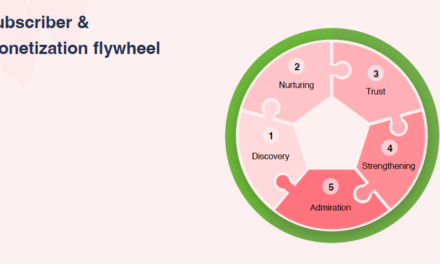As one quarter begins, you would do well to revisit the numbers from the previous quarter – metrics, finances, and time. They can give you a wealth of information to help your content business perform even better in the upcoming months.
1. Revisit your strategic objectives: Pull out your business objectives as a reminder of what metrics you need to know. (If you don’t have goals, create them before you move on to the next thing to do.)
Remember, goals have a general objective, a measurable number, and a timeline to achieve them. For example, your goal might be to grow newsletter subscribers (general objective) by 10% (measurable number) in the first quarter of the year (timeline).
A goal needs an objective, measurable number, and timeline to achieve it, says @AnnGynn. Example: Grow newsletter subscribers by 10% in Q1 2023. Share on XYou have to know your goals before your data is useful. “The companies that are going to win are the ones who are using data, not guessing,” Neil Hoyne, Google’s chief measurement strategist, once said at a Wharton symposium.
2. Update metrics report: If you don’t have a spreadsheet or other dashboard to track your numbers, create one. Update it at least quarterly.
Fortunately – and unfortunately – you have access to a lot of numbers, from your website to your other distribution platforms and tools. Instead of listing every metric available, list only the data categories most relevant to your primary business channel(s) and your objectives.
Start with the obvious, measurable elements. In Google Analytics, these include page views, time on site, bounce rate, etc. In social media, these are followers, impressions, likes, etc. In newsletters, it’s open rates, click rates, etc.
3. Listen to what your audience tells you: Your metrics act as a translator of your audience’s voice – what they’re interested in, what they don’t care about, etc.
Look at the data for patterns or extreme highs or lows. Scrutinize other potentially related metrics or delve deeper into the causes of an anomaly. Sometimes, it helps to turn the spreadsheet numbers into data visualizations to see trends more clearly.
Look at your content data to understand what your audience wants (and doesn't want). Use that to inform your content calendar, says @AnnGynn. #CreatorEconomy Share on XFor example, if your goal is to build brand awareness by doubling your audience on a social platform, look for growth spikes and identify the posts or actions that correspond to that time. Was there a singular topic or area of focus? Did you use particular hashtags or mentions that drove engagement? What were the comments focused on? Look for opportunities to replicate that type of content to see if that has the same effect.
Or perhaps you added a video version of your podcast. Download and viewership data will help you understand if the current audience is interested in both options. If not, is it because they don’t like video, or is it because they aren’t aware of the new video option? To figure that out, you can increase your marketing of the video format in the next quarter to better understand what the Q1 data meant.
4. Examine your finances: Even if your revenue isn’t robust, you still need to pay attention to the money coming in and the money going out. That manifests itself in a profit-and-loss statement where you document your expenses and revenue. (Here’s some help to create a P&L statement.)
Though you spent the money and invoiced to collect the revenue throughout the quarter, a close review of the P&L statement allows you to better understand the big picture. Did you overspend in some categories? Could you cut back, or should you adjust the budget going forward? Did revenue meet expectations? If not, do you need to reassess your marketing? Price points?
How healthy is your business emergency fund? Strive to include at least six months of expenses that you incur no matter how much (or how little) revenue is coming in. These can be things like hosting services, content production costs, software subscriptions, etc., that you need to create.
If you pay yourself from the business revenue, reassess your personal finance numbers, too. For example, have you saved enough money to pay income taxes as well as the self-employment tax rate for Medicare and Social Security? (Self-employed people must pay the 12.4% Medicare and Social Security taxes (up to $142.8K) in the United States.) How is your personal emergency fund doing? (To calculate how much money should be in your emergency fund, NerdWallet has an emergency fund calculator.)
5. Assess your time: You likely spend a lot of hours working on your content business. But how efficiently and effectively do you use that time? To consider that, you first must know how much time you spend and what you do during those hours. That requires tracking your time. (I use Toggl’s free version, but lots of options exist – including old-fashioned pen and paper.) If you didn’t track your time in Q1, estimate it by reviewing your calendar.
Now, you can evaluate how much time you spend on every aspect of the business – content creation, distribution, marketing, business operations, etc. Is that mix delivering what you want? Do you spend an inordinate amount of time on a task because of your inexperience? Maybe you could outsource that responsibility? Are you focusing too much on content creation and not enough on marketing?
To find the answers – and determine what to do next – you should analyze your time at the same time you evaluate your audience data and financial metrics. All three sets of numbers allow you to make fully informed decisions.
Resources:
- How To Set Goals as a Content Entrepreneur
- Use Data To Drive Your Content Strategy
- What Does Your Audience Think of Your Website?
- Personal Finance for Content Entrepreneurs
- Content Plans That Work for You and Your Audience
- Content Calendar [Template]
- How To Make the Most of Your Content Business Time
About the author
Ann regularly combines words and strategy for B2B, B2C, and nonprofits, continuing to live up to her high school nickname, Editor Ann. An IABC Communicator of the Year and founder of G Force Communication, Ann coaches and trains professionals in all things content. Connect with her on LinkedIn and Twitter.










